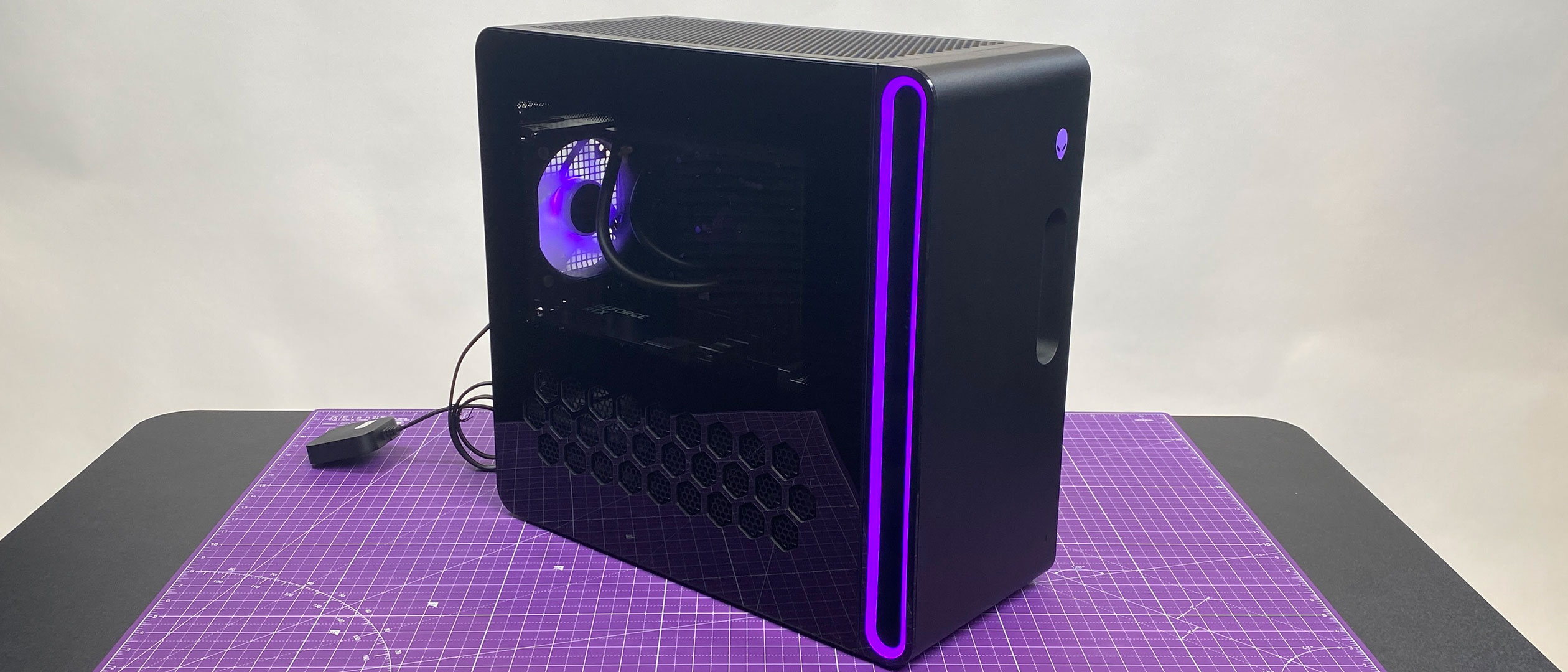
Love or hate the prebuilt scene, Alienware's design, with hints of spaceships and future tech have always stood out, bringing a bit of sci-fi to the traditional black boxes you can grab off of a store shelf. With the Alienware Aurora R16 ($1,749.99 to start, $1,899 as tested), Dell's gaming arm has opted for a more conservative — albeit familiar — approach, keeping the RGB lighting but moving towards a more compact black mid-tower.
But looks are only skin deep. While the redesign changes airflow a bit and makes the R16 easier to fit on your desk, the internal design is still largely the same as past Alienwares, limiting upgrade opportunities if you're using the desktop to get into the PC building hobby.
The specs aren't bad for the price (in the land of prebuilts, anyway, and you could easily spend far more for similar specs, especially if you want to jump up a level in terms of graphics. We'll see how Alienware handles that as more configurations are released.
If you're an Alienware loyalist or want a small mid-tower, this offering will fit for those who prefer to buy rather than build. It has plenty of ports and the difference in size is noticeable.
Design of the Alienware Aurora R16
The external design of the Alienware Aurora R16 is the biggest change in this generation. Gone is the sci-fi inspired spaceship design for something that looks more like a traditional computer. While the internal volume of the case hasn't changed, at 25.2 liters, the desktop is 40% smaller.
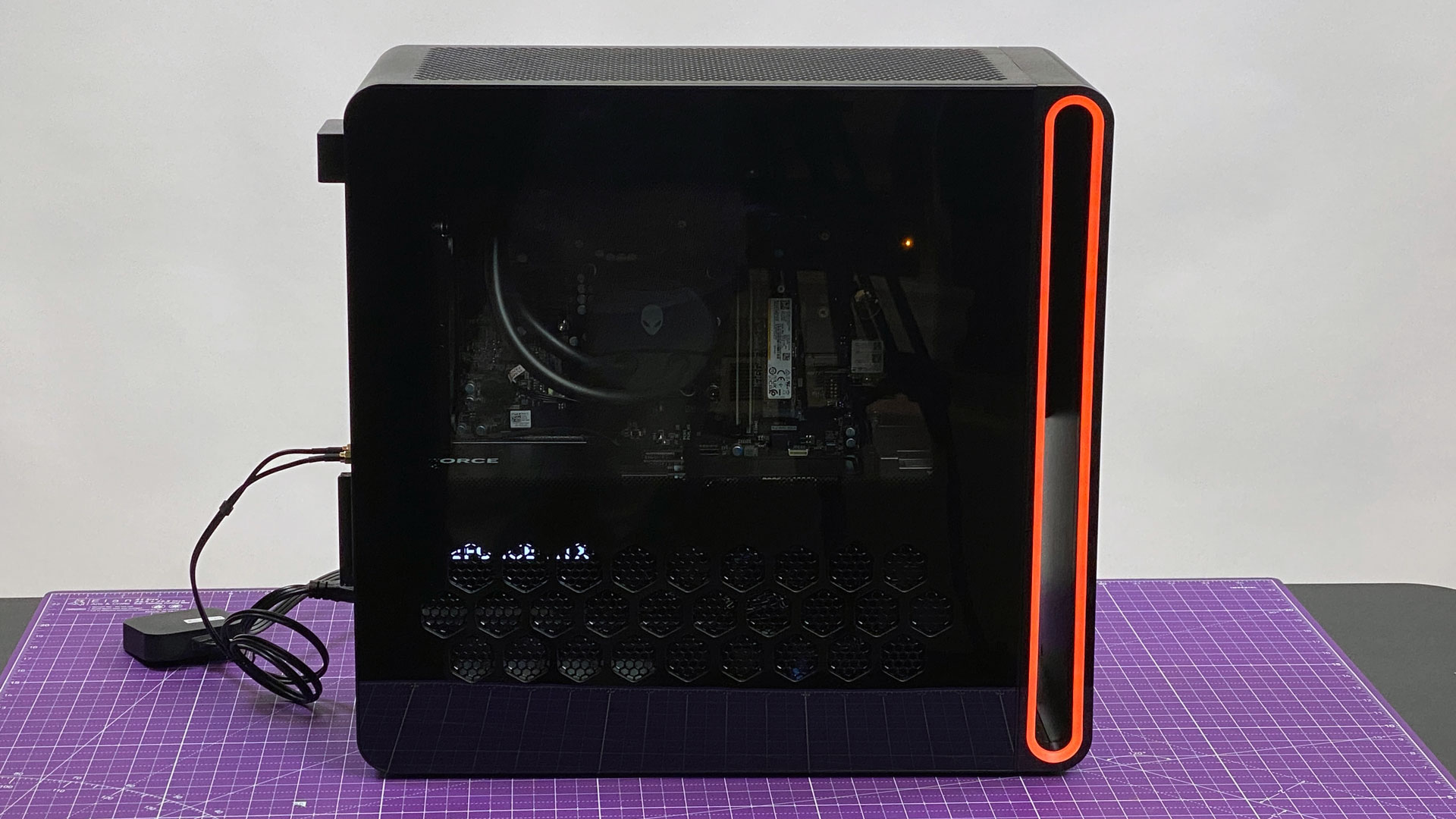
All of this is to say, the Aurora R16 looks more like a desktop PC than previous versions; It's rectangular with rounded corners. There's still an alien schtick, including the oval RGB light from its laptops being moved to the left side of the front panel to serve as an air intake. There's still exhaust out of the top and a mix of intake and exhaust vents on the glass side panel, an idea that debuted on the Alienware Aurora R15 last year (and, frankly, isn't a great aesthetic choice. If you're gonna have a glass window, let me see the whole PC!).
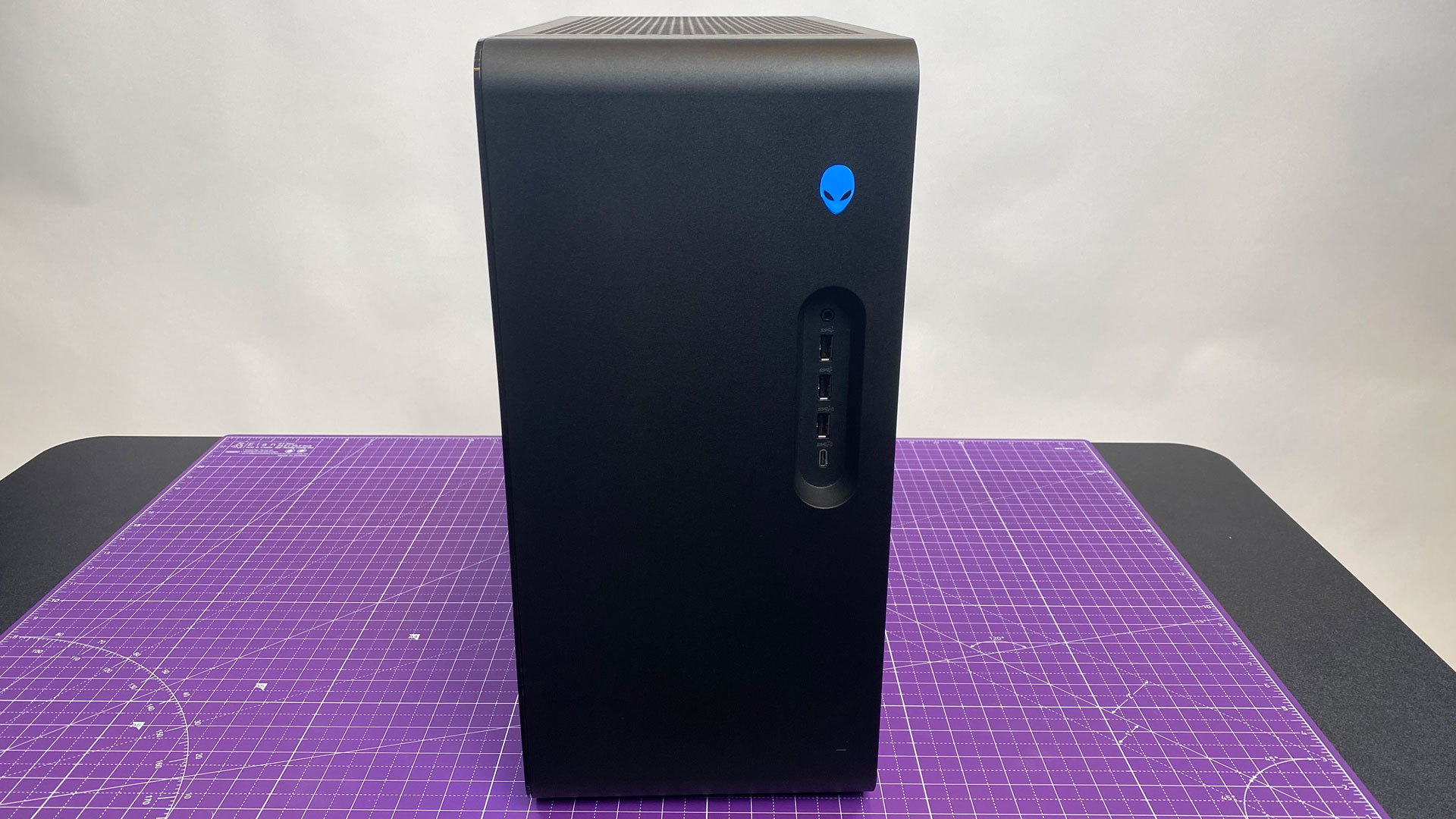
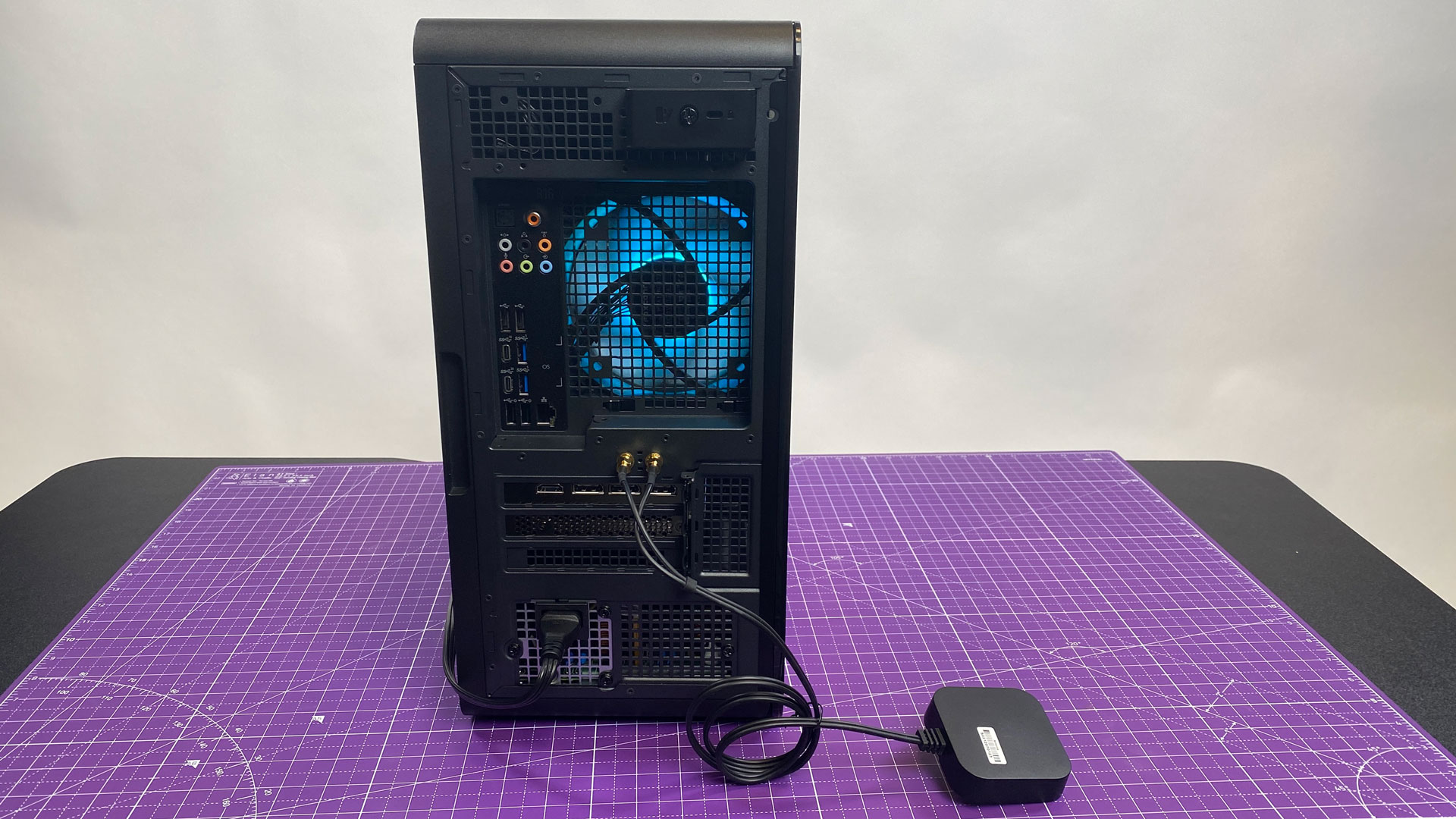
Unlike previous Auroras, the R16 only comes in "basalt" black. The new size, at 18.05 x 16.5 x 7.76 inches is far easier to sit on a desk than the previous generation. Beyond being smaller, Alienware claims that the new design makes the desktop 20% quieter and lets it run 7% cooler. This did not keep me from seriously noticing the noise as I ran our Metro Exodus stress test, in which the fans noticeably whirred the entire time.
This black box does have a few flourishes. The power button is an RGB Alien logo (some things don't change), and there's a cutout in the front for some ports. The left side features a clear window (on some models) and the RGB light ring that doubles as air intake.Though it faces away from you most of the time, I think the oval on the rear side of the case should also light up to add some panache. I also note a lack of lighting inside the PC - only the rear case fan brings any RGB lighting inside the chassis.
While the air still largely exhausts out the top, Alienware claims that this new chassis has a larger surface for exhaust (probably because it's not rounded and covered in excess plastic). But for the most part, this system really is lacking for flair compared to Alienware's prior desktops. One might even call it safe. I'm fine with safe, personally; I prefer practicality and will be spending most of my time looking at the display, anyway. But several of my colleagues looked at this desktop and thought it was boring compared to Alienware's previous designs.

There are four fans in the system: one in the front (that's what pulls air through the RGB ring), one in the rear, and, on our model, two on the 240 mm liquid cooler (the larger cooler was also introduced on the R15). I'd like to see another fan in the front for more intake.
There are no heatsinks or shields here. The RAM, SSD and Wi-Fi are unprotected, and you can even make out all of the labels and barcodes just by looking through the clear side panel. Nevermind keeping components cooler — it would make the whole system look better aesthetically to add that.
The Aurora has shed some mass since we reviewed the previous model, the R15. That one was bigger on all sides at 20.8 x 20.1 x 8.86 inches. Lenovo's Legion Tower 7i (Gen 8), a more conventional box, is 19.37 x 18.27 x 8.31 inches, which is still bigger than the R16 but not tremendously. Maingear's MG-1 is 19 x 16.88 x 8.13 inches.
Alienware Aurora R16 Specifications
Ports and Upgradeability on the Alienware Aurora R16
While the change may be dramatic on the outside, less has changed here than I would like. Alienware is still using a proprietary motherboard that severely hampers major upgrade options down the line. While most people buying a pre-built just want something that will run their games now, those using it as a springboard into the greater hobby won't be able to keep using this PC with new processors once the Intel LGA1700 socket is outdated.
Alienware has offered myriad reasons for its board design over the years. The ports are on the top and bottom, and the I/O board is physically attached, which helps eliminate some wires. That may help Alienware build the PC, but isn't great for future-proofing it. Alienware does like to boast about 12-phase voltage regulation on its boards, however, and I can't blame it for that.
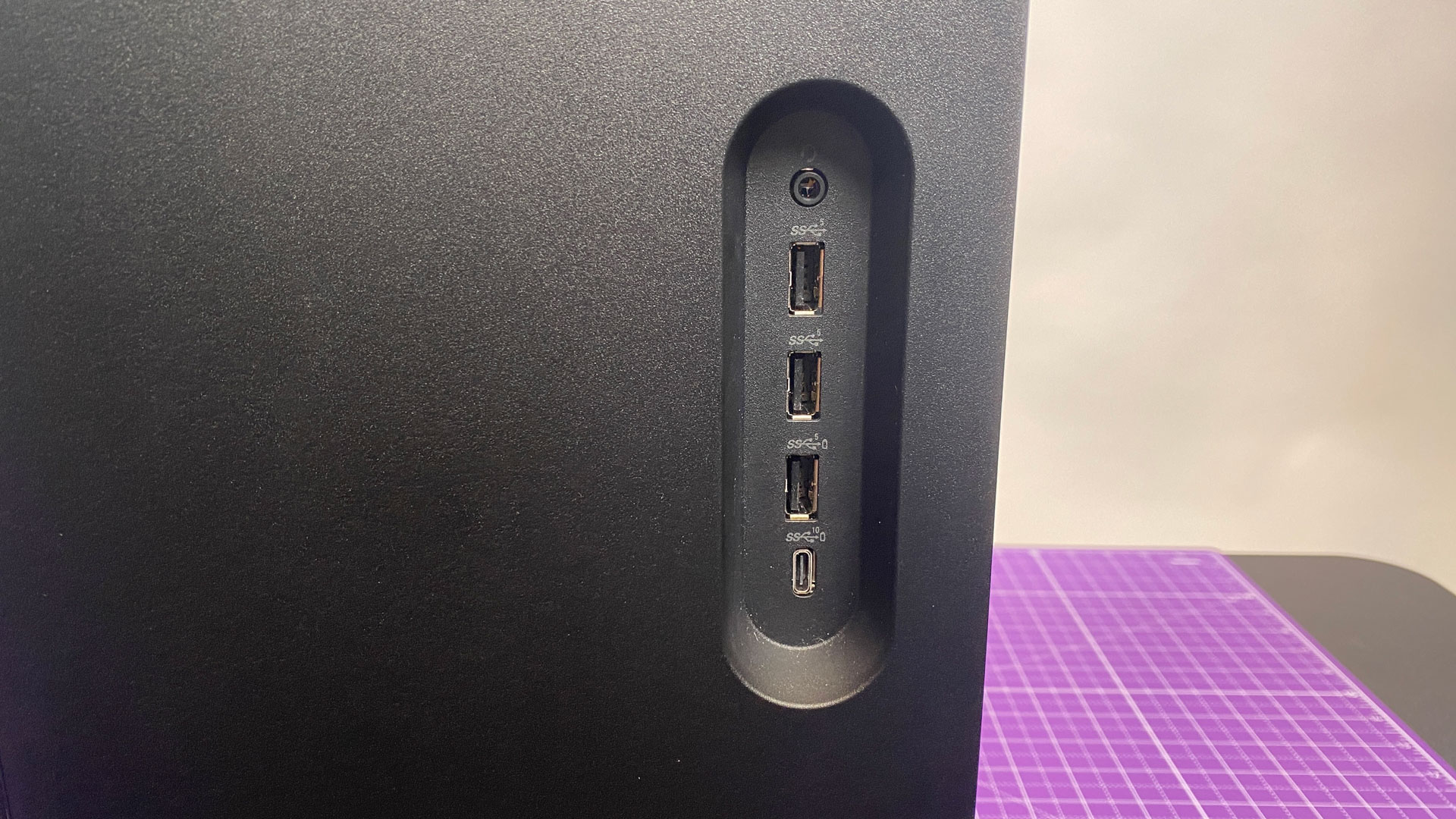
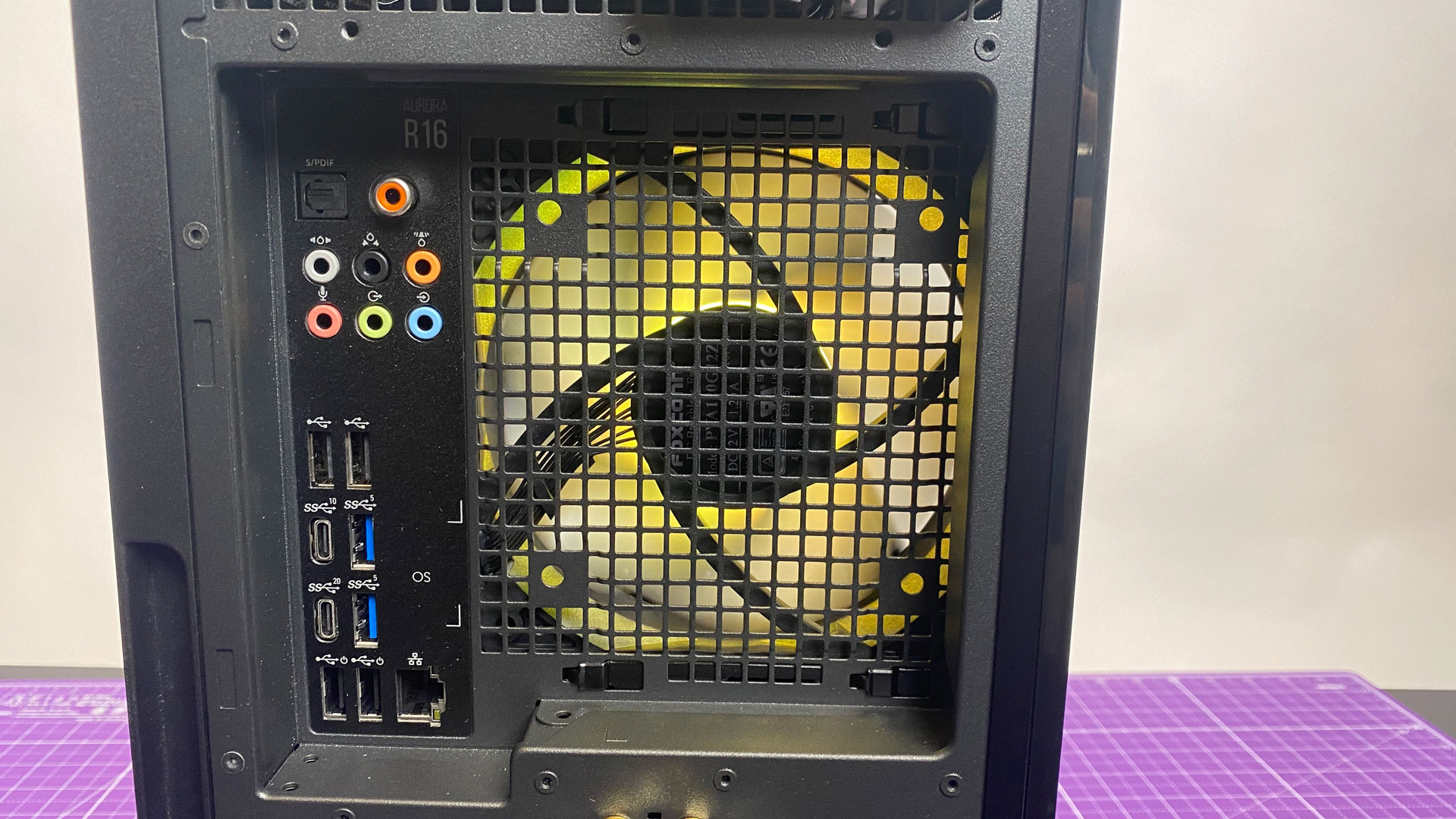
The four front ports are in a small indent. They include a 3.5 mm headphone jack, a generous two USB 3.2 Gen 1 Type-A ports, and a single USB 3.2 Gen 2 Type-C port.
On the back, the ports are largely attached to the motherboard. Those include four USB 2.0 ports, two USB 3.2 Gen 1 Type-A ports, two USB Type-C ports (one Gen 2, the other Gen 2x2), an Ethernet jack, and your usual audio, microphone and SPDIF ports.


To get into the system, you have to loosen a single screw on the back of the system, where a small handle can be used to pop off the glass side panel. (Once this is loosened the first time, you can really leave it that way, unless you plan to travel with the desktop). With the glass off, you can see a slight mess of cables that is obscured by the honeycomb-shaped cutouts on the glass, largely connecting the GPU to the power supply.
Attached to the bottom fan is a plastic bracket that clips onto a metal piece attached to the GPU. Alienware tells me that this is to keep the GPU stable during shipping, and while you can remove it if you please, the company recommends leaving it there. (There's room for another fan at the front and I wish Alienware used it).
While that motherboard can't be replaced (and, likely, the CPU), there is still access to the two RAM slots, the SSD, hard drive cage, and graphics card. The power supply, like previous Alienware desktops, appears to be one meant for servers, so that's yet another area that's not quite easy to upgrade. I do appreciate that there's an extra PCIe SSD slot to fill later with more storage.
To remove the back panel, you give it a good yank and it comes off. But there's just a bit of very clean wiring here. I will give the new design this: getting both side panels back on is far easier than it was on the previous spaceship versions.

Whether or not you like the Aurora's external design (I find it inoffensive), I think it's actually the internals that need an overhaul. I'm not asking Alienware to do what MSI or iBuypower or Maingear do and use nothing custom, but back in 2020 HP, one of Dell's biggest rivals, jumped to bog-standard, name-brand components for most of its Omen builds. Heck, HP even sells its cases separately. If HP can do it, so can Alienware, and when Alienware announced a redesign, I hoped it would also mean that there would be easier repairability and upgradeability. Sadly, that's not the case this time around.
Gaming and Graphics on the Alienware Aurora R16
We tested the Alienware Aurora R16 with an Intel Core i7-13700F and Nvidia GeForce RTX 4070, 32GB of RAM and a 1TB SSD.
I took the Aurora R16 for a spin with Control, still to my mind one of the best PC games of the past few years. At 2560 x 1440 with DLSS on, using the high quality preset and high ray tracing preset, the game ran great. As I dodged Hiss soldiers in a computer lab in the Oldest House's communications department, catching fire that I returned by throwing office supplies with a kinetic charge, the game ran between 82 and 91 frames per second during heavy combat. While exploring, the game typically ran closer to 98 fps.
We actually haven't seen another prebuilt pass through our labs with a 4070 yet — most vendors have opted for expensive, top-end RTX 4080 and 4090 GPUs. So here, we've compared the Aurora to one system that's more expensive and more powerful (the Lenovo Legion Tower 7i with a Core i9-13900KF and RTX 4080) and one that's cheaper and weaker (the Maingear MG-1 Silver, with a Core i5-13400F and an RTX 4060), giving you an idea of what the first Aurora configurations in the United States offer between them. But it's no surprise:
The RTX 4070-powered Aurora always came in the middle of those two in our testing. Don't think of these as a direct comparison, per se, but rather showing the differences between what's available on the market related to the Aurora. You may note that while the 4070 passed muster in 4K, the 4060 did not in several cases; You would need to lower the settings.


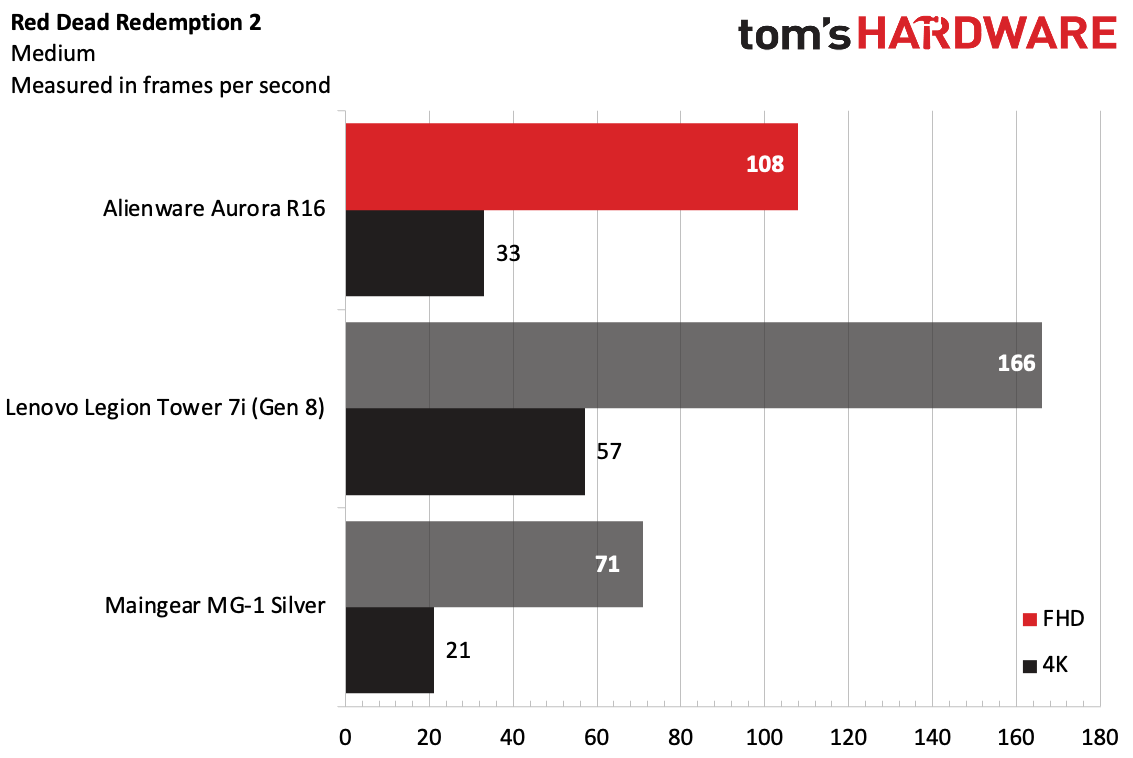


On Shadow of the Tomb Raider's built-in benchmark on the Highest settings preset, the Aurora R16 ran at 161 frames per second at 1080p and 54 fps at 4K.
Grand Theft Auto V (very high settings) is more CPU intensive. Here, the Aurora reached 147 fps at 1080p and 37 fps at 4K.
Meanwhile, Far Cry 6's benchmark on ultra settings ran at 108 fps at 1080p on the Aurora, while it dropped to 63 fps at 4K.The Aurora also ran Red Dead Redemption 2 (medium settings) at 108 fps at 1080p, but that game played at 33 fps at 4K.
On Borderlands 3's built-in benchmark at the "badass" preset, the Aurora ran the game at 144 fps at 1080p and 52 fps at 4K.
To stress test systems, we run the Metro Exodus 15 times at 1080p using the RTX preset, simulating about half an hour of gameplay. The Core i7-13700F's eight performance cores averaged 4.69 GHz, while the eight efficiency cores ran at 3.53 GHz. The CPU package averaged 49.25 degrees Celsius. The RTX 4070 ran at 2,478 MHz and averaged 68.13 C.
Productivity Performance on the Alienware Aurora R16
We also put the Core i7-13700F, the 32GB of RAM and 1TB SSD through their paces in a series of productivity tests.



On Geekbench 6, a synthetic, CPU-heavy test, the Aurora earned a single-core score of 2,529 and a multi-core score of 16,687. Unsurprisingly, that's lower than the Core s i9-13900KF in the Legion and higher than the Core i5-13400F in the Maingear (these patterns will follow throughout). If you're only gaming, though, the Core i9 may be overkill.
The Alienware had the fastest SSD of the bunch, copying 25GB of files at a rate of 1,286.01 MBps, just ahead of the Legion. It's a far superior SSD to the Maingear (489.65 MBps).
Software and Warranty on the Alienware Aurora R16
The most important piece of software preloaded on the machine is Alienware Command Center, now on version 6.0, which is also available on several Alienware (and Dell Gaming) laptops. It's gotten a nice fresh coat of paint and a new user interface, but most of the features are still the same. You get at-a-glance computer utilization stats (you can also see these in an overlay while gaming), overclocking controls and presets, a game library, and Dolby Atmos integration. For those who like their RGB lighting, there's AlienwareFX control in the app as well, which can adjust the lighting not just on the desktop, but also on connected Alienware peripherals and monitors.
While Command Center does a lot, Alienware still has more. None of it is as useful. My Alienware has warranty and system details, but also houses a bunch of simplistic how-tos and links you to Alienware's store to buy more gear. There's also Alienware Customer Connect, which exists to ask you to take surveys, as well as apps for updating your PC (this seems duplicative, Windows does this fine most of the time) and downloading digital content.
Alienware's reach has also extended into the Edge browser, with a folder of links to Alienware and Dell's website, as well as to McAfee Security.
Windows 11 comes with its own bloat (or links to the Microsoft Store) in the Start Menu, including Spotify, WhatsApp, Prime Video, Netflix, Instagram, Facebook Messenger, and Sudoku.
Dell sells the Alienware Aurora R16 with a one-year warranty.
Alienware Aurora R16 Configurations
At launch, configurations of the Alienware Aurora R16 are limited. They all use the Intel Core i7-13700F and Nvidia GeForce RTX 4070. The base model has 16GB of RAM, a 1TB SSD, and 1,000W platinum rated PSU and starts at $1,749.99.
Our review system was almost identical, but bumped up to 32GB of RAM with a $1,899.99 price tag.
There are limited configurations at launch, but a spec sheet that Alienware sent over lists far more options, starting with a Core i9-12900F up through a Core i9-1300F, GPUs between an RTX 3050 up to an RTX 4080 (both only being sold in Asia and Europe at launch), air cooling, an opaque side panel, RAM up to 64GB and storage up to a 4TB SSD and 1TB SATA HDD. All of that is to say, further from launch, there should be a wider range of configurations available, that are both cheaper and pricier than what we tested here.
Bottom Line
Anytime something iconic (or at least attention-grabbing) changes, it's bound to create some strong feelings. Me? I think I prefer Alienware's more compact, traditional mid-tower shape, even if it loses some of the brand's bombast and attitude. It's easier to fit on a desk, easier to open, and, for better or worse, looks more like other options on the market.
What Alienware didn't change was the internals. Most people who buy this, I imagine, just want a working gaming PC that's ready to play out of the box. Alienware delivers on that here. But with proprietary parts, including an oddly shaped motherboard and a server-style PSU, there's limited room for upgrades. For those who get the 1,000W power supply, I hope that will be enough for at least a couple of GPU upgrades.
The design continues to have some pluses, including plenty of ports in the front so that you don't have to reach behind your PC. But it also doesn't do much for noise, at least to my ear.
This all adds up to an atypically safe redesign for Alienware. It's one that's functional and will work for those who simply want to buy a PC, boot up Steam or Epic Games and get started playing with powerful performance. But I hope Alienware's next design finally works on those internals, which are in dire need of a refresh.
MORE: Best Gaming PCs
MORE: Best PC Builds
MORE: Best Gaming Laptops







